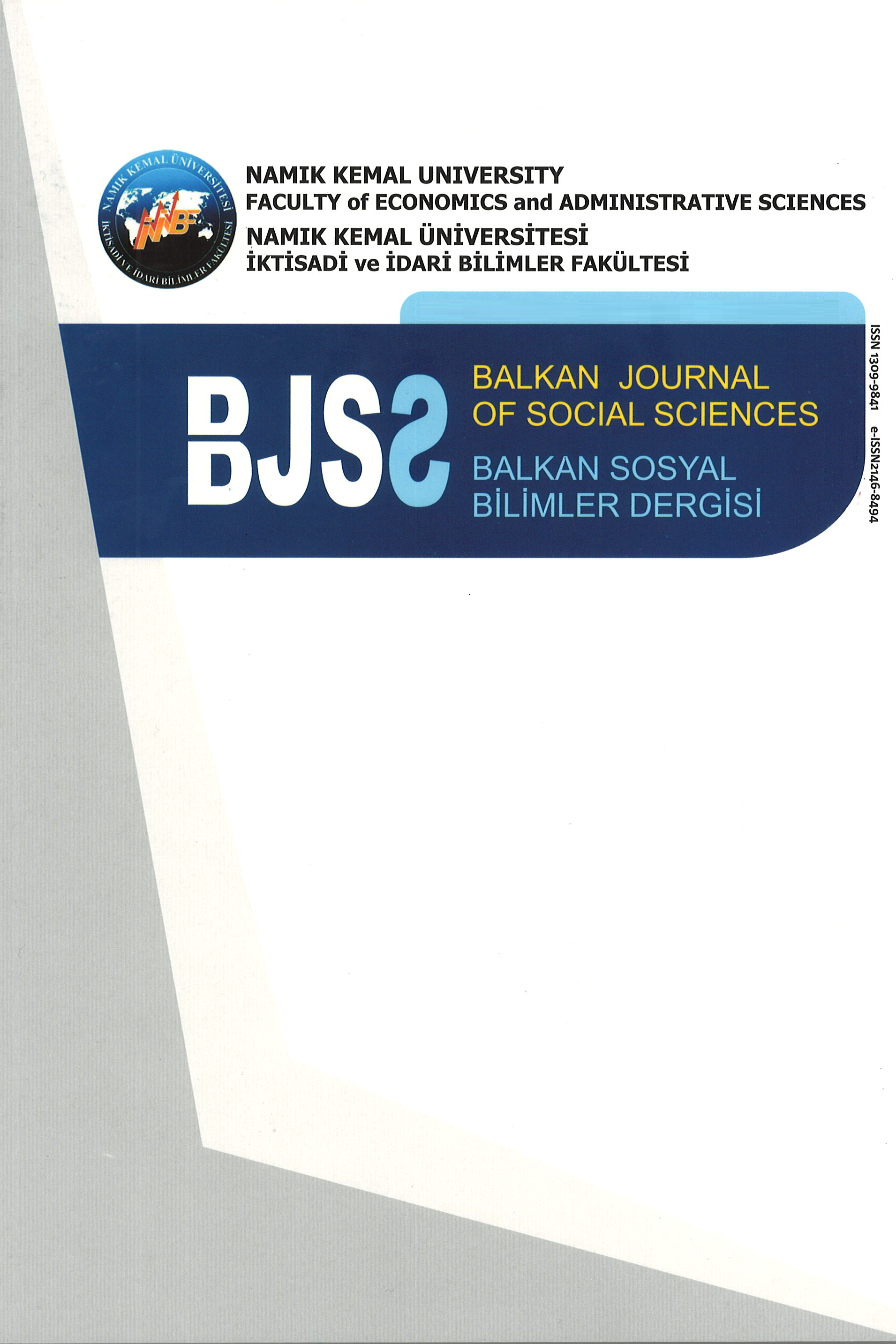TÜTÜN TÜKETİMİNİN EKONOMİK ETKİLERİ VE TÜTÜN KONTROL POLİTİKALARI ÜZERİNE BİR İNCELEME
Tütün bağımlılığı, tüm ülkeler için en önemli halk sağlığı problemidir. Türkiye’nin de içinde bulunduğu coğrafya, dünya tütün tüketiminde birinci sırayı almaktadır. Sigara hem içene hem de topluma çok pahalıya mal olmaktadır. Uzun süreli çalışmalar düzenli içicilerin yarısının alışkanlıkları yüzünden olduğunu göstermektedir. Dünya bankası verilerine göre her yıl tütünün yol açtığı ekonomik zarar 200 milyar dolardır.Bu çalışmanın amacı; Öncelikle sigaranın fiziksel, çevresel ve maliyet açısından insanlara ve devlete verdiği zararlardan bahsetmek, Türkiye’de ve dünyada sigara/tütün ile mücadele etmedeki girişim ve politikalara değinmek, yapılan araştırma sonuçlarından istatiksel olarak söz etmek, sigara/tütünün mali boyutuna değinmektir.
Anahtar Kelimeler:
Sigara/Tütün Yasağı, Sağlık Harcamaları, Mpower Paketi
THE ECONOMIC IMPACT OFTOBACCO CONSUMPTION AND A DETERMINATION OF TOBACCO CONTROL POLICIES
Tobacco dependence is the most important public health problem for all countries. The geography also includes Turkey is in the first place for tobacco consumption. The cost of tobacco dependence is very costly for both individual and communty levels. The long run studies shows that regular smoking caused by routine. According the World Bank data economic damage caused by tobacco is 200 bilion dolar for every year.The purpose of this study is mention to phsycal, enviromental and financial damages caused by tobacco for individuals and government, refer to the policies for struggle against the cigarette/ tobacco in Turkey and in world, cite to statistical results of researchs on this issue and address the financial dimenson of cigarette / tobacco dependence.
___
- Annual smoking-attributable mortality, years of potential life lost, and economic costs-United States, 1995-1999. MMWR Morb Mortal Wkly Rep 2002;51:300-3.
- Crews KM, Payne TJ. Tobacco update: scientific advances, clinical perspectives. Am J Med Sci 2003;326:165-6.
- Çom S., Temel Sağlık Hizmetleri Genel Müdürü, MPOWER (tütün salgınını kontrol etmeye yönelik politika paketi). 2013.
- DSÖ, Türkiye’de Etkili Tütün Kontrol Politikalarının Uygulanması Üzerine Ortak Ulusal Kapasite Değerlendirilmesi, 2010
- DSÖ, Türkiye’de Tütün Kontrolü Politikaları, 2010
- Esin A, Bilir N, Aslan D. Health care expenditures of lung cancer: a Turkish experience. Turkish Respiratory Journal, 2004, 5:15– 16.
- Hasan SU. ATS statement-cigarette smoking and health. Am J Respir Crit Care Med 1996;154:1579-80.
- Karlıkaya C. Edirne’de orta öğretim öğrencilerinde sigara içme prevalansı. Toraks Dergisi 2002;3:6-12.
- Kaufman N, Yach D. Tobacco control-challenges and prospects. Bull World Health Organ 2000;78:867.
- Kocabas A. Orta dereceli okul öğrencilerinde sigara icme alışkanlığı. Ankara Tıp Mecmuası 1988;41:9-22.
- Mpower (tütün salgınını kontrol etmeye yönelik politika paketi). 2013.
- Nielsen K, Fiore MC.Cost-benefit analysis of sustained-release bupropion, nicotine patch, or both for smoking cessation. Prev Med. 2000;30(3):209-16.
- Parrott S, Godfrey C, Raw M et al. Guidance for commissioners on the cost effectiveness of smoking cessation interventions. Health Educational Authority. Thorax 1998;53 (Suppl5):S1-38.
- PIAR Araştırma Ltd. Şti. Sağlık ve Sosyal Yardım Bakanlığı, sigara alışkanlıkları ve sigara ile mücadele kampanyası kamuoyu araştırması raporu. 1988. İstanbul.
- Sağlık Bakanlığı, Tütün Kontrolü Çerçeve Sözleşmesi, 2008, Ankara
- Satman I, Yılmaz T, Şengul A et al. Population-based study of diabetes and risk characteristics in Turkey: results of the turkish diabetes epidemiology study (TURDEP). Diabetes Care 2002;25:1551-6.
- Sigara Sağlık Ulusal Komitesi web sitesi. http://www.ssuk.org.tr. Erişim: 5.11.2014.
- Tuncer M.A., Sağlık Bakanlığı Kanserle Savaş Dairesi Başkanı, Hacettepe Üniversitesi Tıp Fakültesi Pediatrik Hematoloji B.D Öğretim Üyesi, Kanserin Ülkemiz ve Dünyadaki Önemi, Hastalık Yükü ve Kanser Kontrol Politikaları, Aralık 2009, ANKARA.
- Türk Kardiyoloji Derneği. Türkiye Kalp Raporu 2000. İstanbul: Yenilik Basımevi; 2000. 16. Şahin M, Arslandağ M. Kardiyovaskuler sistem ve sigara. In: Tur A; ed. Sigaranın bilimsel yüzü. İstanbul: Logos Yayıncılık; 2005.
- Türk Toraks Derneği, Türkiye’de Tütün Kontrolü Görüş Raporu, 20.06.2014 Tütün Mamullerinin Zararlarının Önlenmesine Dair Kanun, No 4207, 26 Kasım 1996 tarihli ve 22829 sayılı Resmi Gazete (Değişiklik, 03.01.2008 tarih ve 5727 Sayılı Kanun, 19 Ocak 2008 tarihli ve 26761 sayılı Resmi Gazete.
- Vineis P, Airoldi L, Veglia P et al. Environmental tobacco smoke and risk of respiratory cancer and chronic obstructive pulmonary disease in former smokers and never smokers in the EPIC prospective study. BMJ 2005;330:277.
- Warner KE. Cost effectiveness of smoking-cessation therapies. Interpretation of the evidence-and implications for coverage. Pharmacoeconomics 1997;11:538-49.
- Warren CW, Riley L, Asma S et al. Tobacco use by youth: a surveillance report from the Global Youth Tobacco Survey project. Bull World Health Organ 2000;78:868-76.
- World Bank. Curbing the Epidemic: Governments and the Economics of Tobacco Control. 1999. Washington, World Bank.
- World Health Organization. The tobacco epidemic rages on in Eastern and Central Europe. Fact Sheet No. 156. Geneva, Switzerland; 1997.
- World Health Organization. WHO report on the global tobacco epidemic, 2008. the MPOWER package. Geneva, World Health Organization, 2008 (http://www.who.int/tobacco/mpower/en/index.html. accessed 21 March 2008).
- Yayın Aralığı: Yılda 2 Sayı
- Başlangıç: 2011
- Yayıncı: Tekirdağ Namık Kemal Üniversitesi
Sayıdaki Diğer Makaleler
ALLAH ALGISI ÖLÇEĞİ TÜRKÇE FORMUNUN GEÇERLİK VE GÜVENİRLİĞİ
NGUGI WA THIONG’O TARAFINDAN YAZILAN MATİGARİ ‘DEKİ YERLİ SEÇKİNLER
YAKINSAMA HİPOTEZİ: BALKAN ÜLKELERİ ÖRNEĞİ
Özge Bariş TÜZEMEN, Samet TÜZEMEN
TÜTÜN TÜKETİMİNİN EKONOMİK ETKİLERİ VE TÜTÜN KONTROL POLİTİKALARI ÜZERİNE BİR İNCELEME
AVRUPA BİRLİĞİ VE İZMİR İŞGÜCÜ PİYASALARI: TOPLUMSAL CİNSİYET AÇISINDAN BİR DEĞERLENDİRİLME
